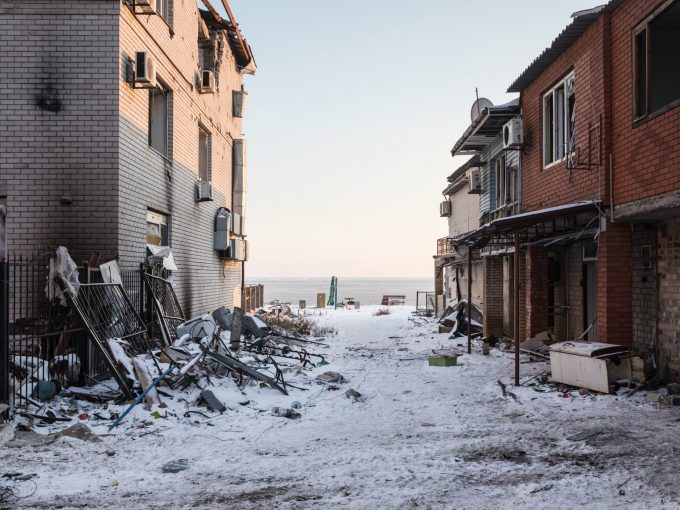Sharing knowledge for the recovery of Ukraine
Executive Summary
This executive summary is from full report authored by Oleksandr Anisimov and Pavlo Fedoriv (New Housing Policy, UA), Oleksandra Tkachenko (UNUN), Julie Lawson (RMIT Centre for Urban Research) and Edwin Buitelaar (Utrecht University) and published by PBL, the Dutch government’s National Agency for Environmental Assessment.
This report responds to Ukraine’s ambitions for the recovery of homes and neighbourhoods. It calls on policymakers in Ukraine, partner countries and international organisations to give strategic attention to safe, affordable, and energy-efficient housing in future recovery efforts.
The destruction and devastation since the full-scale invasion in 2022 have been immense. Almost six million people are internally displaced within Ukraine, while another eight million have fled to neighbouring countries. War-induced impoverishment has led to over 40% of households having exhausted their savings and close to 40% of internally displaced people (IDP) needing assistance with paying the rent. As of early 2023, housing is the most impacted sector of all, with over 817,000 homes damaged affecting two million residents and at an estimate cost of USD 40 billion.
Notwithstanding the importance of dealing with these urgent challenges, many housing problems that Ukraine is facing today are systemic and have been present since long before the full-scale war. And so have the solutions, in other countries of Europe that are commonly considered exemplary when it comes to providing safe and affordable housing. On the basis of the symposium ‘Ukrainian housing recovery forum’ in The Hague, in early 2023, we drew and developed a number of lessons and challenges for Ukraine. In this report building blocks for the structuring of Ukraine’s recovery are presented, based on experiences with best practices form all over Europe. It is up to Ukraine and its international partners to take the next steps.
Better access to affordable housing is crucial for households affected by the war. Today’s housing system does not offer much choice for most families and especially the displaced people. Because of the poorly regulated private rental market, millions are facing an unsafe and insecure housing situation. The social housing stock in 2021 accounted for just over 1,000 units countrywide. The absence of public and semi-public housing providers, such as municipal housing organisations, cooperatives and associations further complicates the situation.
A range of housing options beyond individual homeownership could help ensure safe, secure and affordable housing for all Ukrainians. The not-for-profit rental housing such as in many European countries offers a proven model for Ukraine to build on. Housing associations, cooperatives and municipal organisations have shown to reliably provide energy-efficient and high-quality rental housing alternatives. Such a model requires a strategic long-term investment framework and good regulation. This report demonstrates how well these systems work in other countries, such as in Austria and Denmark.
The Ukrainian housing system requires a national vision followed by a coherent legal framework that responds to current societal needs. The existing regulations pertaining to social housing are inconsistent and complex. Common definitions, allocation mechanisms, and economic models of social, municipal, and non-profit housing are lacking. This prevents effective countrywide progress in developing new housing stock with donor investments.
A National Housing Strategy would provide a clearer governance framework for the activities of the national government, regions (oblast) and municipalities (hromada) as well as the European Union and other international actors in the realm of housing. New legislation for non-profit (municipal and cooperative) and private housing could include regulation and accountability for housing providers. Conditional investment and supervision can ensure that rents and fees cover efficient operating costs and that any revenue surpluses are used for expanding affordable housing.
Public subsidies for socially just and economically efficient housing. The organisation responsible for the implementation of housing programmes is Derzhmolodzhytlo. Over the course of 30 years, it has provided housing subsidies to over 40,000 households with little control over quality and sustainability. At the same time, most of the government financing never reached the vulnerable groups, even as the need for housing was growing. Furthermore, the current utility subsidies draw on the national budget which is eroding resources for investment in new construction. The government has little resources and capacity to fulfil its role in housing provision.
To analyse countywide needs and coordinate government funding, a dedicated national housing agency and national housing fund with the appropriate resources seem pivotal. Finland’s ARA provides a leading role model for such an agency that works closely with municipal governments. Through investments, steering and monitoring, ARA ensures that subsidised housing is of high quality, sustainable and affordable. Next to direct provision of public housing, ARA uses tools that stimulate the provision of private affordable housing, such as competitive conditional public grants, long-term loans, interest subsidies and guarantees. Such a model ensures that initial investments remain in the housing system in perpetuity.
A new approach towards managing multi-apartment buildings. Currently, there is a considerable backlog in maintenance and energy-efficiency modernisation. Furthermore, only about 20% of such buildings have established homeowners associations. Notably, for decades, there has been no money available for major renovations of multi-apartment buildings funded by households themselves, which has led to deterioration and lack of funds for modernisation of these buildings today. Low-income households have difficulties in accessing scarcely available renovation funds.
There is a need to supply multi-apartment buildings with management structures and clear understanding of ownership rights and obligations. New management and financial models have to be developed for sustainable management of the housing stock to improve housing conditions while securing the right to adequate housing for both low- and middle-income households. The renovation wave has the potential of practical implementation of the EU’s Energy Efficiency Directive and Energy Performance of Buildings Directive. A focus on the reconstruction of the soviet-era micro-districts will allow them to adhere to the Green New Deal and CO2-reduction targets, both during reconstruction and over the buildings’ lifetime. As it is in the soft renewal programme in Vienna, such a policy can increase the attractiveness of the cities for the Ukrainians who are looking to return from other countries. This will also boost the quality of life in the existing neighbourhoods and prevent continuing urban sprawl.
More local expertise and capacity are necessary. According to current legislation, social housing provision is a municipal responsibility, but few resources are dedicated to fulfilling this role on national or local levels. Ukrainian municipalities’ have limited human resources and fiscal capacity. They also lack clear government authority and guidance regarding the aims and tasks of housing provision, such as integrated planning for housing and sustainable social housing operation models. Civil initiatives have proven indispensable in the emergency response, but their role in housing recovery is underutilised and needs to be supported.
To increase municipal skills and planning regarding housing, a comprehensive capacity building programme could be initiated. The local planning bodies in Ukraine could use active and facilitative land policy instruments to ensure affordable and integrated housing development. Local land banks could provide suitable land for subsequent housing projects, especially in combination with government or international investment. Forms of ‘inclusionary zoning’, as exist in the Netherlands and Austria, ensure that private developers include affordable housing alongside other types of real estate. Vienna’s Wohnfonds supports not-for-profit housing that is embedded in a vibrant context of other homes, green space, amenities, schools, accessible jobs and public transport via developer competitions and strategic land release. Such instruments effectively promote diverse and balanced neighbourhoods.
A national to local housing finance interface has to be introduced. Access to national and international finance on the level of municipalities is rather limited and restricted. Also, to date, no framework for non-profit operating models and revolving funds has been developed.
A national housing fund and national housing agency are both key to driving the local responsibilities for housing with conditional needs-based investment. To ensure a comprehensive redevelopment of the territories with new mobility and social infrastructure as well as affordable housing multi-level agreements can be implemented. In Finland, ‘MAL’ agreements (country–region–municipality) bring together commitments and knowledge from local councils and the fiscal capacity of the national government towards common goals.
International partners and donors can provide Ukraine with technical assistance to establish coherent housing legislation, a strong national agency together with a dedicated national fund, and to invest in municipal capacity-building in planning and shaping the development of affordable housing and liveable neighbourhoods.
Excerpt from Anisimov, O. Fedoriv, P. and Tkachenko, O., Lawson, J. and Buitelaar, E. (2023), Rebuilding a place to call home. Sharing knowledge for the recovery of Ukraine, The Hague: PBL Netherlands Environmental Assessment Agency.
Full report available in English and Ukrainian.





